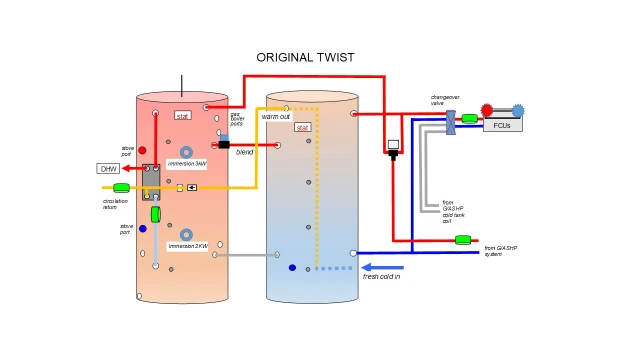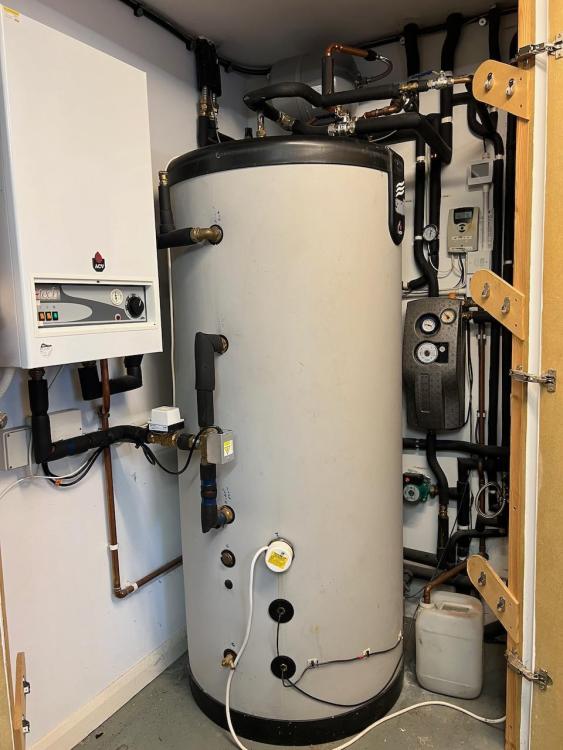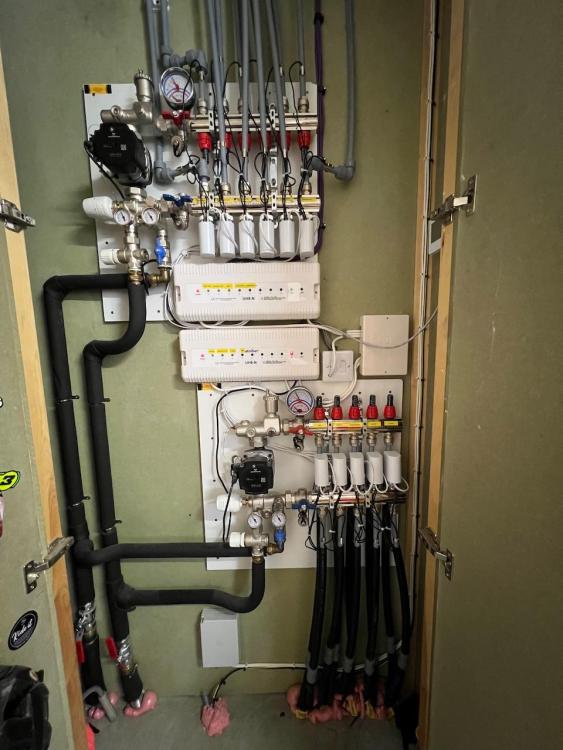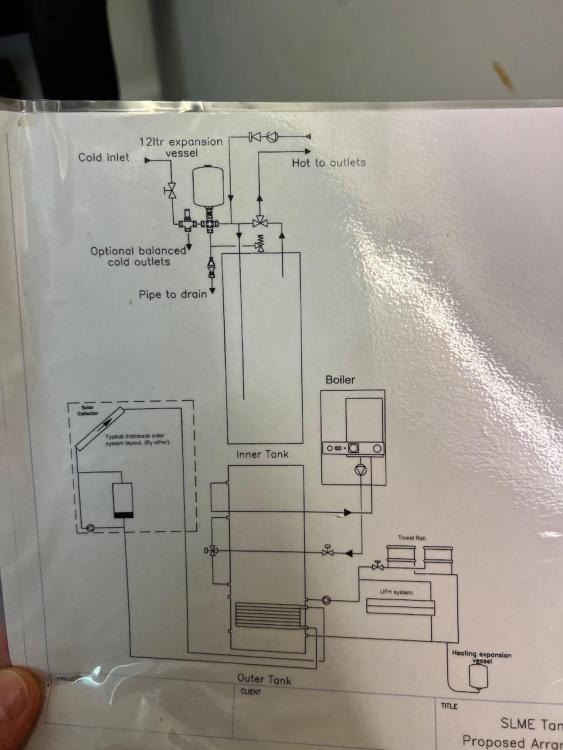
tw18
Members-
Posts
12 -
Joined
-
Last visited
Recent Profile Visitors
The recent visitors block is disabled and is not being shown to other users.
tw18's Achievements

Member (3/5)
1
Reputation
-
Yes for hot water circulation. It is on a timer 0700 - 2230, if you have shower outside those times it's cold period, no just waiting a couple of mins, you can stand it in for 15 mins and it won't get any warmer. Consequently I get shouted at if it gets turned off.
-
So the boiler has been off for 2 hours, with no heating on and just the circulation pump running. No-one is at home so no water has been used, but here is the temp drop from the cylinder. In 2 hours, is that normal?
-
Haven't had it checked. But the daily readings from the supplier are close to what I get from my own monitor so I have never felt to call them into question.
-
Oh yes, I've not got a seaview or are costal by any means, but there isn't much between my place and the Atlantic, today's its 35 mph winds from the west. But that's a good point I've got a dodgy hinge on 1 window, but all of the trades are still busy from Storm Ciarán so aren't interested in a small job, I'll make some phone calls again.
-
Just found something I'd cut out of my original post to keep it short, but feel it might be worthwhile posting up for context and The house is actually 1 of 2. There are also 2 other different and bigger properties (on the development of 4), but the common thread with everyone else is the UFH is super expensive to run (hence my focus on it)! But they say this is offset by not paying for hot water in the summer (due to the solar thermal), which doesn’t make sense when you’re doing 100 kWh pd in the winter! Between the 2 houses there are now differences, as early on the original ACV tank of the sister house developed a leak, and got replaced with a smaller one (I believe the 400L and they've had no issues). And then there was a fire in the manifold cupboard of our house (as a result of some telecoms equipment), which meant new manifolds, wiring centre, pumps, flow controls and actuators were retro fitted. Given the new system and controls I have had the original plumber around (who is one of the bigger reputable firms locally), who was unable to provide any actual details of how it should be setup, run of configured (apart from saying all flow meters were just set to 2.5) and simply directed me to someone he claimed was the original supplier / system designer (who of course they turned out not to be). I have also spoken to the original architect practise but again given that it was 10 years plus they haven’t been able to provide any details of the floor makeup either. So I have no idea on loop lengths, pipe diameter, pipe spacing, floor makeup etc. The plumbers words were ‘back then UFH was new and we had no idea what we were doing so we were led by the manufactures, and most of what they sold us hasn’t turned out to be true’. What I can tell you is that the UFH loop from the cylinder runs straight into the garage floor on its way to the manifolds and seemingly heats up the garage slab / floor which means the is garage is some 20+ degrees (right now the boiler cupboard is 31 degrees, the garage is 20.5 and the rest of the house is circa 20). There is a patch on the floor, by the door to the garage that is the warmest part of the house! Thanks, I don't know how (yet) but something else to understand. Found someone's that got a thermal camera for the phone which I'm gonna borrow.
-
OK, so I think I've read and digested all of the above (again thanks to everyone for their contributions). The interesting take away has been, the focus on the building design, construction etc. In my naive way I had focused on the heating and hot water system, controls and various variables and concluded the boiler and tank setup was the biggest problem. I haven't seen a positive thing writing about the tank in tank design and I was thinking along the lines of that I've got 1 body of water heated to 60 degrees, which is conflicting as the under floor heating is set to want a lower temp but is circulating that hot water and stirs up the tank. Which when I've read about low temperature heating and just circulating 30 odd degree water in the slab is potentially more efficient, but is something in the current design I cannot do. Which had lead me think that going to with a 2 cylinder design (I've seen people refer to the concept and pre-heating) would be better and something that could've been done for under 5k, and would've been beneficial should an ASHP come down the line. This shows the idea Source - https://originaltwist.com/2019/11/26/heating-system-for-heat-pump-2020-revision/ All I know is that I’ve only scratched the surface on hydronics, such as I’ve seen diagrams where the implication is the water should circulate in a loop, with it being tee’d off to go to the UFH manifolds, where mine appears not. But then I don’t know if that is more applicable to condensing boilers as appear to be more of the norm in the UK. So is this an incorrect interptetation on myside?
-
Oh, so I was just digging through my emails as I was sure I had managed to gleam some information out of the architects practice. They said that "the building design was approved back in 2006/7 and the thermal performance was set at a good level then. Of course since then building regs have set higher standards and windows have got a lot better as standard. Roof Construction - 0.18 W/m²K Wall Construction - 0.35 W/m²K Floor Construction - 0.25 W/m²K New Windows - 2.1 W/m²K The walls are a standard timber frame construction with an external skin of rendered blockwork. The roof construction is a warm roof configuration." In the loft I've got circa 100mm of rockwook type insulation above the ceilings and then 100mm of kindspam between the roof joists. The floor is unknown, it looks like I asked the questions but didn't get an answer to that one! So you're saying its bad, like 4 times worse that yours, but what would a passive house be, 2/3 times better than average? So we are kind of on a time of use. We've recently moved from E20 (a cheaper off-peak for 20 hours for the boiler circuit) tariff to E20 Plus (all day electric for the boiler, but you pay a premium between 1300-1500 and 1700-1900) as we we're running out of hot water between the previous 1630 - 1910 outage (which then lead to the boiler being on constantly for 2/3 hours and the heat drop / loss taking hours to recover from. So the methodogly was that it would be cheaper to take the hit on the more expensive tariff as you'd be saving the other side, to which the jury is still out on. @SteamyTea Thank you, that's alot to digest, I will come back to you on that one. Although I think I've for the logging part down. FYI the boiler is now set to 60. it previously used to be set to 80 odd. That was just a note on what the plumbers had quoted for, and given the load I'd been using seemed to be in the ballpark.
-
Wow, genuinely thank you! I did not expect that many replies! I will try my best to answer what I can and get back to you all! We have now, but only recently do we've had a £5k matched funding scheme introduced. So consequently most plumbers are busy jamming those in any way shape or form they can. I guess similar to scheemes in the UK, where the appropriateness or efficiency of the whole design is questionable. As someone's already said the pipe comes from the solar thermal, some sort of over flow. Correct, there isn't a gas line to where we are (and don't get me wrong we're not out in the sticks, we're just in a main village on this 9 by 5 mile island). And given the whole island had a 2 week gas outage last year their future isn't looking bright! TBH that was just a side note, when I did my calculations of how much it was going to cost vs save, it was as still 13-18 years before it had paid back. I just remember recalling at the time the 'service life expectancy' of a unit being circa 10 years so had factored that into the budget which they it didn't make sense. So along with the ST and this switching the boiler off completely in the warmer months, we do also have a wood burning stove in the lounge, which Nov-Feb gets used in anger if not daily. This does have the side effect of disrupting the downstairs thermostats as they'll then not kick in to circa 0400 the next morning after the fire's been on. Over time as part of my 'notes' the boilers 'on' times have changed with a view to seeing how the costs were and how the whole system responded. So to a point I know that a bath cost in x kwh, a shower in y and even have a concept of how much the hot water circulation including its pump cost us. So I've got a sparky mate and a builder mate... just need to make a plumber mate, but given the circa 8k cost for a 12-16kw unit when I looked at it, it still didn't make financial sense. Then I was still under the impression that the whole system might not 'be' right I was left considering if that was good money after bad. Hence the ultimately generic post of is 100-120 kwh pd 'ok'. So over time I've experimented with the primary and secondary bypasses on the manifolds (to little or no scientific resolve) and of course the mixer valves on them. When I moved in the previous owners had the mixer to both the upstairs and downstairs UFH manifold set at 60. Now they're set at 45, with the bypasses high to return mostly hot water to the electric boiler in a effort to stop its constant short cycling (again my interpretation in layman's terms). The downstairs stats are set to 19.5 with a 0.5 degree swing before the heating kicks in. @TerryE I know how to quote, I just didn't need to as I was just referencing some topics which had struck home. I'll look to quote you in the morning.
-
I’ll start by saying sorry for the long post which I’ve already cut down 2/3 times as I have tried hard to keep it shortish figuring that I can reply with details later should it be needed and start with some background. Our previous house was a 2008 build, 1100sqft, 2 storey semi-detached 3 bed. It was fully electric, with 2 storage heaters and 4 panel heaters. DHW was a 250L unvented cylinder heated with just an immersion heater. The heating and hot water we’re only on for 8 hours a day because of a ‘comfort heat’ tariff. We had 2 young kids back then so would have been running half a bath or 2 most nights as well. The house was always warm, and we never ran out of hot water. In the heating season it would do circa 25kw per day, just on the heating and hot water and was circa 12kw pd for the rest of the year, so that’ll just be water. In the summer of ’21 we moved to a new (to us) house that was also built in 2008, this time 1800sqft, 4 bed, detached with integrated garage, and again 2 storeys. It is also electric only, comprising of a 22kw electric boiler (which is actually downrated to 15kw, something to do with limits on the 3-phase supply) and wet underfloor heating on both floors. Downstairs is a slab of unknown construction and upstairs is suspended. Everything is fed into and from a 600L AVC tank in tank cylinder. It also has solar thermal, again original to its build in ’08. What am I surprised by is that in the heating season it will chew through an eye watering 100kw pd, I’ve even seen it do over 120 when it is close to 0 degrees outside. And it is not like the house is super-hot or anything, if anything the opposite is true. Given the shock of the first winters heating in the summer of ’22 the thermostats got changed out for Heatmiser NeoStats, and the ACV cylinder got hooked up to some temperature probes via the solar controller. Along with the pre-existing energy monitor all these feed into home assistant for monitoring / logging, which truth be told doesn’t help as you get to see the scary figures on a daily basis! Towards the end of ’22, Salus Auto Balancing Actuators also got fitted. Now the bigger problem stems from the fact I live on the small island of Jersey. So, I have had multiple plumbers around and all they ever say is that I need to install a heat pump at a cost of 13k. Which when I do the calculations it won’t appear to pay me back for 13-18 years, and potentially has a 10-year life span. So surely that cannot be the answer. They never proposed any other changes. I have already blabbered on too long, so will just say that I’ve read, changed, evaluated many things on this journey, seeing as no-one locally seems to be able to advise any better (my notes are currently 35 pages and still going). Over the last 3 years I’ve read with great interest this forum and threads / blogs, such as newhome’s nightmare heating system, TerryE’s timed and calculated willis heating of his slab and then seen revelations like JohnMo’s major modifications to his heating system including a plate heat exchanger. Which leaves me wondering how bad is it? I’ve only the comparison of our old house to go off and the fact that people are telling me that it is expensive comparatively. If I look up the average UK energy usage it tells me that that we are well above average, which given the fact that I turn the boiler off for 4/5 months of the year (due to the solar thermal) alarms me. Is there even a problem, is this expected usage? Is it expensive to run? Is there a configuration or design issue? As a picture says a thousand words, here are a few although I’m not sure how accurate the layout diagram actually is, but it gives some context.
-
So, it is worth a follow up for research / documentation purposes. I did go ahead and put the 11 of the Salus THB23030 - Auto Balancing Actuators in. With my Heatmiser Neo setup I had set my ‘output delay’ to 5 mins to avoid them quickly switching on / off and potentially doing it within the 2 min period required to set it into the recalibration mode. A year or so later and it’s an interesting story. Downstairs with the slab there definitely been a noticeable benefit. Upstairs and the jury is out. More often than not things are fine for 3 weeks that I have a zone or 2 that just kind of stalls, other zones on that manifold are flowing, but 1 or 2 will just stop and quickly reduce the flow to almost nothing and require a recalibration to kick them back into life. I also had 1 ABA that decided not to close and left the zone wide open and only noticed it when the room was too hot! That also took a recalibration to sort out. Likewise the support hasn’t been great, they are super responsive until you have a problem, then they ignore you for months, and then all they do is tell you to recalibrate it! I see they’re got a replacement ABA in the works, but it’s not available yet, so I imagine the ones I’ve got are very much a Gen1 product with the accompanied teething issues.
-
Unfortunately, that is a good question. The house was built in 2008 and compromises of 2 manifolds (1 for each floor) running 11 loops (5 ground floor and 6 on the 1st floor). There was a fire in the garage some years back and any pipe layout details / diagrams were lost, but subsequently new manifolds, wiring centre, pumps, flow controls and actuators were fitted. I have had the original plumber around who was unable to provide any actual details and directed me to someone he claimed was the original supplier (of course they turned out not to be), I’ve spoken to the original architect practise but again given that it was 10 years plus they haven’t been able to provide any details of the floor makeup either. So I have no idea on loop lengths, pipe diameter, pipe spacing, floor makeup etc. The plumbers words were ‘back then UFH was new and we had no idea what we were doing so we were led by the manufactures, and most of what they sold us hasn’t turned out to be true’. I’ve been in the house 15 months and last winter the floors never felt like they got up to temperature. The whole system is really really slow to respond. The plumber had just set all of the flow rates to 2.5 after the fire. I have looked at tweaking them, but it would appear that the ABA’s are the magic ticket to managing and potentially getting the flows right as I look to get the most out of what there is.
-
Hey guys, looking to the community to help fill in the gaps re Salus auto balancing actuators with Heatmiser wiring centres and NeoStats. I’ve read the many threads on the subject, of which the majority seemingly saying yes they work more often than not, but the forums are also littered with stories of them not. Wundatrade site and support says that they do not even when I pointed them to the following post ‘https://forum.buildhub.org.uk/topic/13229-help-with-salus-auto-balancing-actuators/?do=findComment&comment=220266’ in which another member claimed that they Wunda had a different opinion. I’ve read that there is a newer revision that has a different IMAX that works with the Neo’s, but can find no hard evidence of this or reference to any change or different version. Is anyone able to shed any light on this? And finally I’ve read that if the Neo’s calls are too short and frequent that they can send the ABA’s into a re-calibration mode. Is anyone able to confirm this and what cycle time / settings they’ve set on the Neo’s? Any one able to offer any advice or experience on the matter?




.thumb.jpeg.6eb9fdc673f10d963870fe82c24f67f5.jpeg)


